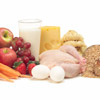- What is a protein shake?
- Why do people drink protein shakes?
- Do protein shakes work?
- What happens to excess protein?
- Benefits of protein shakes
- Risks of protein shakes
- Limitations of protein shakes
- Alternatives to protein shakes
What is a protein shake?

Why do people drink protein shakes?
Most people drink protein shakes because they want their muscles to grow bigger. Muscles grow when your body synthesises proteins into muscle tissue. Exercising stimulates the protein synthesis process, which occurs most rapidly in the period of rest following exercise. However the extent to which muscles grow is also influenced by the amount of protein available in your body.
Protein shakes are an excellent source of protein and people usually drink them after exercising (when protein synthesis is occurring most rapidly) to maximise the benefits of exercise. Muscular development is also dependent on the levels of insulin and amino acids, which stimulate the process of protein synthesis. This is why many protein shakes also contain added amino acids and glucose rich carbohydrates.
Do protein shakes work?
Studies show that protein shakes increase muscle anabolism (i.e. the process of muscle development) when consumed immediately following exercise. However, not all protein powders are the same. It appears that formulas with added amino acids and glucose rich carbohydrates are more effective than those containing only proteins.
What happens to excess protein?
Like the energy and nutrients you consume when eating, the protein you consume in a shake must be digested by your body. Despite popular myth, there is no evidence that the additional protein consumed through protein shakes damages the kidneys. If protein is not converted to muscle, it will be converted into and stored by your body as fat.
Benefits of protein shakes

- They contain quantities of protein which are difficult to consume quickly through eating alone.
- They can be consumed immediately after exercise without suppressing appetite or causing bloating.
In addition, there is evidence that consuming protein shakes after exercise may:
- Counteract the immune suppression effect (i.e. the tendency for the body’s immune system to become less effective in protecting against disease) which can occur after intensive exercise;
- Aid bone formation;
- Reduce the risk of muscular and joint injuries;
- Reduce the risk of viral and bacterial infections;
- Reduce the risk of heat exhaustion;and
- Reduce muscular soreness following exercise, probably due to the anti-inflammatory effect of increased insulin.
Risks of protein shakes
There is no scientific evidence of increased health risks resulting from the consumption of high protein beverages.
Limitations of protein shakes
While there are few adverse health risks, there are a number of limitations of protein shakes.
- They do not address other factors which reduce muscle anabolism. For example, post-exercise hypo-hydration, which, if not corrected (e.g. by drinking milk following a workout) can compromise performance in subsequent exercise sessions;
- They contain almost exclusively protein. Other essential nutrients (e.g. carbohydrates, oils, vitamins and minerals) and micronutrients (e.g. iodine, calcium, vitamin A) contained in dietary sources of protein are generally absent;
- Protein shakes may have a bitter taste;
- A protein shake is not an armchair workout! They maximise the effects of resistance exercise, but do not work in the absence of it.
Alternatives to protein shakes

For professional and amateur athletes, body builders, and others who wish to rapidly increase muscle density, the benefits of protein shakes may outweigh the costs. As there are no known health risks, the financial costs appear to be the main concern. However, maintaining a generally healthy diet that is low in fat, alcohol, salt and refined sugars is also an important part of maximising exercise benefits.
For individuals who simply want to develop healthy muscle tone, eating a well-balanced but protein rich diet is probably sufficient. Such a diet will ensure the availability of protein for synthesis following exercise. Good sources of dietary protein include:
- Lean meat: Lean chicken and fish are lower in fat than pork, lamb, beef and other meats.
- Low fat dairy products, particularly low fat milk: Milk also has a positive effect on post exercise rehydration, which has been shown to optimise exercise efficiency.
- Beans, legumes and nuts: Good sources of vegetable protein, but remember that nuts are high in fat and should only be eaten in small handfuls.
More information
 |
For more information on food groups and components, see Types and Composition of Food. |
 |
For more information on nutrition, including information on nutrition and people, conditions related to nutrition, and diets and recipes, as well as some useful videos and tools, see Nutrition. |
 |
For more information on fitness and exercise, including stretches, types of exercise, exercise recovery and exercise with health conditions, as well as some useful videos, see Fitness and Exercise. |
References
- Manninen AH. Hyperinsulinaemia, hyperaminoacidaemia and post-exercise muscle anabolism: The search for the optimal recovery drink. Br J Sports Med. 2006;40(11):900-5. [Abstract | Full text]
- Manninen AH. Protein hydrolysates in sports and exercise: A brief review. J Sports Med Sci. 2004;3(2):60-3. [Abstract | Full text]
- Bucci LR, Unlu L. Protein and amino acid supplements in exercise and sport. In: Wolinsky I, Driskell JA (eds). Energy-Yielding Macronutrients and Energy Metabolism in Sports Nutrition. Boca Raton, FL: CRC Press; 2000: 191-212. [Book]
- Bennet WM, Connacher AA, Scrimgeour CM, et al. Euglycemic hyperinsulinemia augments amino acid uptake by human leg tissues during hyperaminoacidemia. Am J Physiol. 1990;259(2 Pt 1):E185-94. [Abstract]
- Borsheim E, Cree MG, Tipton KD, et al. Effect of carbohydrate intake on net muscle protein synthesis during recovery from resistance exercise. J Appl Physiol. 2004;96(2):674-8. [Abstract | Full text]
- Lemon PW, Berardi JM, Noreen EE. The role of protein and amino acid supplements in the athlete’s diet: Does type or timing of ingestion matter? Curr Sports Med Rep. 2002;1(4):214-21. [Abstract]
- Koopman R, Wagenmakers AJ, Manders RJ, et al. Combined ingestion of protein and free leucine with carbohydrate increases postexercise muscle protein synthesis in vivo in male subjects. Am J Physiol Endocrinol Metab. 2005;288(4):E645-53. [Abstract | Full text]
- Grimble GK. Mechanisms of peptide and amino acid transport and their regulation. In: Fürst P, Young V (eds). Proteins, Peptides and Amino Acids in Enteral Nutrition. Basel: Karger and Nestec; 2000: 63-88. [Book]
- Nutrition fact sheet: Protein [online]. Chicago, IL: Northwestern University Feinburg School of Medicine; 2008 [cited July 2008]. Available from: URL link
- Kreider RB, Earnest CP, Lundberg J, et al. Effects of ingesting protein with various forms of carbohydrate following resistance-exercise on substrate availability and markers of anabolism, catabolism, and immunity. J Int Soc Sports Nutr. 2007;4:18. [Abstract | Full text]
- Bonjour JP. Dietary protein: An essential nutrient for bone health. J Am Coll Nutr. 2005;24(6 Suppl):526-36S. [Abstract | Full text]
- Flakoll PJ, Judy T, Flinn K, et al. Postexercise protein supplementation improves health and muscle soreness during basic military training in Marine recruits. J Appl Physiol. 2004;96(3):951-6. [Abstract | Full text]
- Manninen AH. High-protein diets and purported adverse effects: Where is the evidence? Sports Nutr Rev J. 2004;1(1):45-51. [Abstract | Full text]
- Poortmans JR, Dellalieux O. Do regular high-protein diets have potential health risks on kidney function in athletes? Int J Sports Nutr Exerc Metab. 2000;10(1):28-38. [Abstract]
- Knight EL, Stampfer MJ, Hankinson SE, et al. The impact of protein intake on renal function decline in women with normal renal function or mild renal insufficiency. Ann Intern Med. 2003;138(6):460-7. [Abstract | Full text]
- Shirreffs SM, Watson P, Maughan RJ. Milk as an effective post-exercise rehydration drink. Br J Nutr. 2007;98(1):173-80. [Abstract | Full text]
All content and media on the HealthEngine Blog is created and published online for informational purposes only. It is not intended to be a substitute for professional medical advice and should not be relied on as health or personal advice. Always seek the guidance of your doctor or other qualified health professional with any questions you may have regarding your health or a medical condition. Never disregard the advice of a medical professional, or delay in seeking it because of something you have read on this Website. If you think you may have a medical emergency, call your doctor, go to the nearest hospital emergency department, or call the emergency services immediately.







